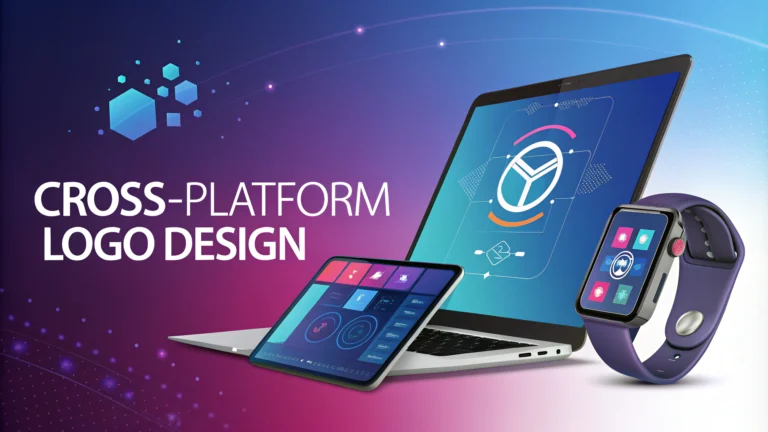Creating logos that work seamlessly across different platforms and devices requires careful planning and strategic design choices.
A well-designed cross-platform logo maintains its visual impact whether it appears on a tiny mobile icon or a massive billboard.
Essential Design Elements
- Simple shapes and clean lines
- Limited color palette (2-3 colors maximum)
- Clear visibility at various sizes
- Balanced negative space
- Vector-based graphics for scalability
Technical Specifications
| Platform | Recommended Size | Format |
|---|---|---|
| Website favicon | 16×16 pixels | ICO, PNG |
| Social media profile | 400×400 pixels | PNG, JPG |
| Mobile app icon | 1024×1024 pixels | PNG |
Quick Tips for Success
Test your logo design across multiple devices and screen sizes before finalizing.
Create variations of your logo for different backgrounds and contexts – light, dark, and transparent versions.
Save your logo in multiple file formats: AI or EPS for editing, PNG for web use, and SVG for responsive design.
Common Mistakes to Avoid
- Using too many gradients or complex effects
- Relying on fine details that disappear at small sizes
- Ignoring spacing requirements for different platforms
- Creating designs that don’t work in monochrome
Tools and Resources
- Adobe Illustrator: Industry standard for vector logo design
- Sketch: Popular among UI/UX designers for digital-first logos
- Figma: Collaborative design tool with excellent export options
Consider working with a professional designer through platforms like Behance or Dribbble for complex cross-platform logo projects.
Testing Your Logo
- Print the logo at various sizes
- View on different devices and browsers
- Check against competitor logos
- Get feedback from target audience
Document your logo usage guidelines to maintain consistency across all platforms and applications.
File Organization
Create a structured folder system with separate directories for web, print, and social media versions of your logo.
Keep original source files separate from ready-to-use versions to prevent accidental modifications.
Version Control
Implement a clear version control system for your logo files to track changes and maintain consistency across platforms.
- Date-stamp file names
- Track revision history
- Document any modifications
- Archive outdated versions
Color Management
Digital Colors
- RGB values for screen display
- HEX codes for web use
- Save color swatches
Print Colors
- CMYK values for print materials
- Pantone colors for consistency
- Spot color variations
Responsive Design Considerations
Create responsive logo variants that adapt to different screen sizes and contexts while maintaining brand recognition.
- Simplified versions for small screens
- Extended versions for desktop
- Alternate layouts for different aspect ratios
Legal Protection
Secure your logo design through proper legal channels to protect your brand identity.
- Trademark registration
- Copyright documentation
- Usage rights documentation
Conclusion
Creating effective cross-platform logos requires careful attention to technical specifications, design principles, and implementation strategies. Success depends on thorough testing, proper file management, and consistent application across all platforms.
Regular review and updates of your logo assets ensure continued effectiveness and relevance in an ever-evolving digital landscape. Remember to document all guidelines and maintain organized file systems for seamless brand consistency.
FAQs
- What makes a logo design truly cross-platform compatible?
A cross-platform logo should maintain its visual integrity across all mediums and sizes, from large billboards to small mobile icons, with clear visibility, scalability, and consistent color reproduction. - Should I create different logo versions for different platforms?
Yes, you should develop a logo system with variations including horizontal, vertical, icon-only, and responsive versions to ensure optimal display across all digital and print platforms. - What file formats are essential for cross-platform logo design?
Essential formats include vector files (AI, EPS, SVG), raster files (PNG, JPEG), and specific sizes for social media platforms, app icons, and favicon requirements. - How do I ensure my logo colors appear consistent across different devices?
Use standardized color systems like Pantone for print and both RGB and HEX values for digital platforms, and test the logo across various devices to verify color consistency. - What’s the minimum size requirement for a cross-platform logo?
The logo should remain legible at 16×16 pixels (favicon size) while maintaining its impact at larger sizes. Test readability at various dimensions to ensure versatility. - How do I handle logo transparency across different platforms?
Use PNG format with transparency for digital platforms, ensure the logo works on both light and dark backgrounds, and provide alternative versions when transparency isn’t supported. - What typography considerations are important for cross-platform logos?
Choose fonts that are legible at small sizes, consider web-safe alternatives, and convert text to outlines in vector files to maintain consistency across platforms. - How should I adapt my logo for social media profiles?
Create square, circular, and rectangular versions that meet each platform’s specific requirements, ensuring the logo remains recognizable within different crop formats. - What’s the importance of negative space in cross-platform logos?
Adequate negative space ensures the logo remains clear and uncrowded when scaled down, particularly important for mobile applications and small digital displays. - How can I future-proof my cross-platform logo design?
Create a simple, versatile design that avoids trendy elements, use vector formats for scalability, and maintain comprehensive brand guidelines for consistent implementation.







